What's New
Displaying results 3791 - 3800 of 4911
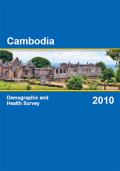
Resource | Publications,
The 2010 Cambodia Demographic and Health Survey (CDHS) is a nationally representative sample survey of 18,754 women and 8,239 men age 15-49. The 2010 CDHS is the third comprehensive survey conducted in Cambodia as part of the worldwide MEASURE DHS project. The primary purpose of the CDHS is to provide policymakers and planners with up-todate, reliable data on fertility; family planning; infant, child, and maternal mortality; maternal and child health; nutrition; malaria; knowledge of HIV/AIDS, and women’s status.
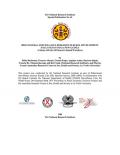
Resource | Publications,
The behavioural surveillance survey (BSS) research conducted by the National Research Institute at Oil Search Limited provides data for the NDoH National Surveillance System for monitoring behavioural trends with more-at-risk populations over time. The research is also conducted for OSL and the NDoH/ADB HIV Prevention in Rural Enclaves Project, to be used as a baseline for the monitoring and evaluation of their HIV project. The BSS research findings are based on a representative sample of 463 OSL workers and can support further tailoring of the OSL HIV prevention response to minimize the impact of the HIV epidemic on their workforce and their surrounding communities.
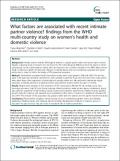
Resource | Publications,
Intimate partner violence (IPV) against women is a global public health and human rights concern. Despite a growing body of research into risk factors for IPV, methodological differences limit the extent to which comparisons can be made between studies. We used data from ten countries included in the WHO Multi-country Study on Women’s Health and Domestic Violence to identify factors that are consistently associated with abuse across sites, in order to inform the design of IPV prevention programs.
IPV prevention programs should increase focus on transforming gender norms and attitudes, addressing childhood abuse, and reducing harmful drinking. Development initiatives to improve access to education for girls and boys may also have an important role in violence prevention.
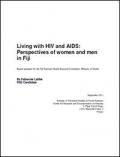
Resource | Publications,
This report presents the results of the study entitled Discourses and Representations of HIV in Fiji and their Impact on the Experience of People Living with HIV and AIDS.
This study, as originally conceived and described in the research proposal submitted to the Fiji National Health Research Committee, aimed to investigate the discourses and representations of HIV and AIDS in Fiji and how they impact the experience of people living with the virus. This research had three initial objectives: 1) to examine how HIV and AIDS had been presented and represented at the institutional level (government, nongovernmental organizations (NGOs), churches) since the advent of the first reported cases in 1989; 2) to explore how the population of Fiji perceived and interpreted the infection; 3) to analyse the biographies of people living with HIV and how they experienced the virus in the Fijian context.
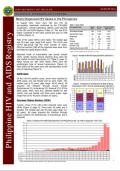
Resource | Fact Sheets,
In August 2011, there were 196 new HIV Ab seropositive individuals confirmed by the STD/AIDS Cooperative Central Laboratory (SACCL) and reported to the HIV and AIDS Registry (Table 1). This was 81% higher compared to the same period last year (n=108 in 2010) [Figure 1].
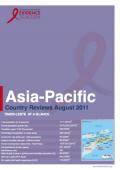
Resource | Reviews and Snapshots,
In 2003, the first case of HIV was reported in Timor-Leste (commonly know as East Timor). As of 2009, there were 151 cumulative reported cases of HIV - among whom 71 were female, 80 were male and 14 were children.
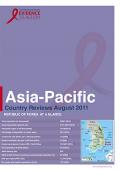
Resource | Reviews and Snapshots,
The reported cumulative number of Koreans testing positive for HIV has more than doubled in the last five years from 2,470 in 2003 to 6,936 in March 2010. The number of newly recorded HIV cases in the Republic of Korea decreased by about 3% (771 new cases) in 2009 after a 7% increase in 2008 (797 new cases), according to a report released from the Korea Centers for Disease Control and Prevention (KCDC).
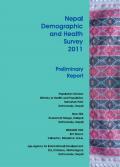
Resource | Publications,
The Nepal Demographic and Health Survey (NDHS) 2011 is conducted as a periodic update of the demographic and health situation in Nepal. This is the fourth comprehensive national level population and health survey conducted in Nepal as part of the global Demographic and Health Surveys (DHS) program.
The primary focus of the 2011 NDHS was to provide estimates of key population and health indicators, including fertility and mortality rates, for the country as a whole and for urban and rural areas separately. In addition, the sample was designed to provide estimates of most key variables for the 13 ecodevelopment regions (stratums).
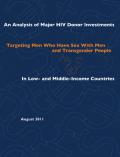
Resource | Publications,
In low- and middle-income countries, substantial resources for the AIDS response come from the largest bilateral, multilateral, and private philanthropic donors and from a country’s contribution to addressing its own epidemic. There is no reliable indication of what overall proportion of these resources ultimately reaches men who have sex with men (MSM) and transgender people.
Our objective was to examine major donor investments targeted at these two groups in 2009, but we also recorded relevant information from other years (2008, 2010, and 2011) when available.
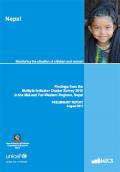
Resource | Publications,
This preliminary report is based on the Nepal Multiple monitor progress made over the past decade on children's Indicator Cluster Survey (NMICS), conducted in 2010 by and women's issues. It will also help to identify the regional the Central Bureau of Statistics (CBS) with technical and geographical disparities that exist within the country financial support from UNICEF. The survey is intended, in and will establish a baseline for some newly developed large part, to fill the data gap that has existed in the Mid-Western and Far-Western regions of Nepal in addition to indicators, the progress status of which can be monitored preparing for the national-level MICS in 2013.





